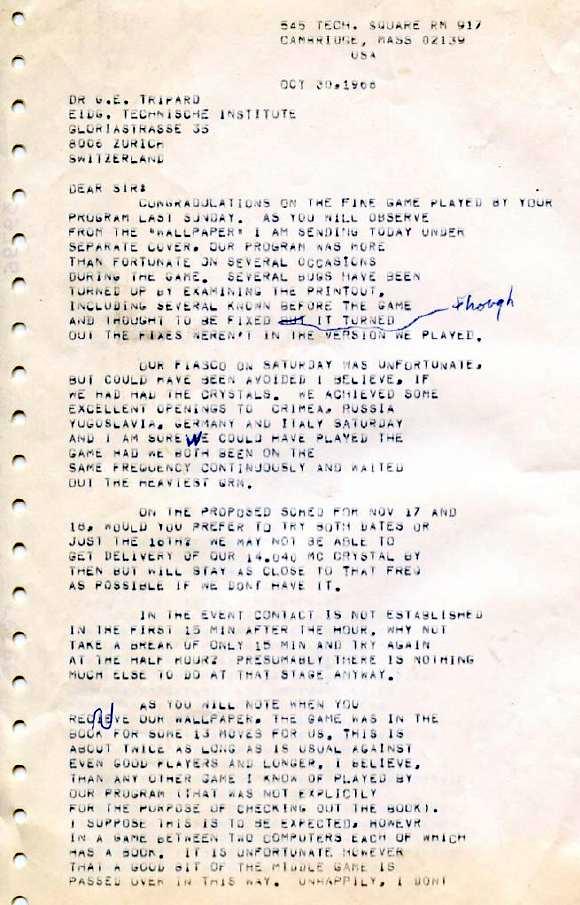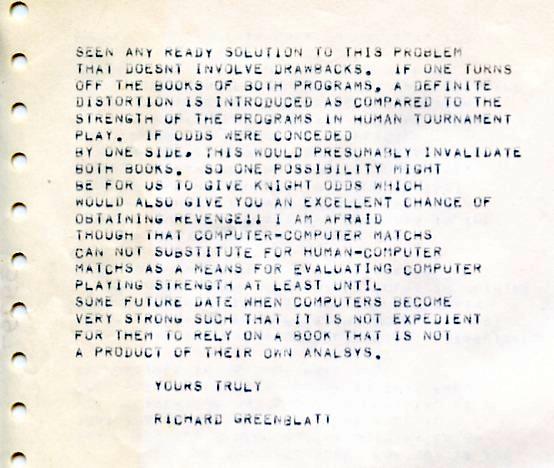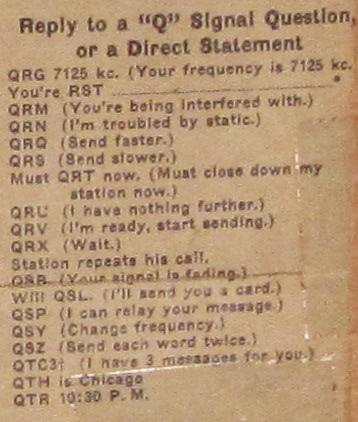|
This letter was apparently sent by Richard Greenblatt after the initial game on Sunday, October 27, 1968. I'm not sure why I have a copy printed on a line-printer. Perhaps that's how Greenblatt wrote it, on a text editor, before printing a better copy to actually mail. It might have been sent as either a letter or a telegram. Although images below the following text depict the actual copy I have, which includes edit notations, here's the text in a more easily readable form. I've corrected a few typos and misspellings that don't seem that have been caught at the time, at least in the copy I have. 545 Tech. Square, Rm. 917
Dr G.E. Tripard
Dear Sir:
Congratulations on the fine game played by your program last Sunday. As you will observe from the "Wallpaper" I am sending today under separate cover, our program was more than fortunate on several occasions during the game. Several bugs have been turned up by examining the printout, including several known before the game and thought to be fixed though it turned out the fixes weren't in the version we played.
Our fiasco on Saturday was unfortunate, but could have been avoided I believe, if we had had the crystals. We achieved some excellent openings to Crimea, Russia, Yugoslavia, Germany and Italy Saturday and I am sure we could have played the game had we both been on the same frequency continuously and waited out the heaviest QRM.
On the proposed sched for Nov 17 and 18, would you prefer to try both dates or just the 18th? We may not be able to get delivery of our 14.040 MC crystal by then but will stay as close to that freq as possible if we don't have it.
In the event contact is not established in the first 15 min after the hour, why not take a break of only 15 min and try again at the half hour? Presumably there is nothing much else to do at that stage anyway.
As you will note when you receive our wallpaper, the game was in the book for some 13 moves for us. This is about twice as long as is usual against even good players and longer, I believe, than any other game I know of played by our program (that was not explicitly for the purpose of checking out the book). I suppose this is to be expected, however, in a game between two computers each of which has a book. It is unfortunate however that a good bit of the middle game is passed over in this way. Unhappily, I don't see any ready solution to this problem that doesn't involve drawbacks. If one turns off the books of both programs, a definite distortion is introduced as compared to the strength of the programs in human tournament play. If odds were conceded by one side, this would presumably invalidate both books. So one possibility might be for us to give knight odds which would also give you an excellent chance of obtaining revenge!! I am afraid though that computer-computer matches can not substitute for human-computer matches as a means for evaluating computer playing strength at least until some future date when computers become very strong such that it is not expedient for them to rely on a book that is not a product of their own analysis.
Yours truly, Richard Greenblatt Some notes on the above: The "Wallpaper" Greenblatt refers to is evidently line-printer output created during the game. It generally showed all possible moves at each ply, as ranked by the "Plausible Move Generator" module of the program, sorted in order of goodness as ranked by that module. Generally, only about six of these were evaluated in depth, although a larger number might be looked at under certain circumstances. The printout then showed the results of the lookahead on each move evaluated in the lookahead tree. This printout was referred to as "wallpaper" because it could be hundreds of pages, printed on standard sprocket-fed line-printer paper that was 11 inches high, by 14 7/8 inches wide. The odd width was because the sheets were often perforated to allow removal of a 7/16-wide inch strip on each side containing the sprocket holes. This left a page 11 inches high by 14 inches wide. Greenblatt refers to "QRM". For those not familiar with ham radio, "QRM" refers to radio interference. This is one of a list of "Q-signals" used as an abbreviation, particularly when communicating in Morse code. A list of the most commonly used Q-signals was posted on my radio rig above the receiver, along with other information. Note Greenblatt's use of the abbreviation "MC" for "MegaCycles per second". Nowadays we would say "MHz" for "Megahertz". The use of the term "hertz" for "cycles per second" had been adopted in 1960, but even in 1968, people would occasionally use the older term.
     |